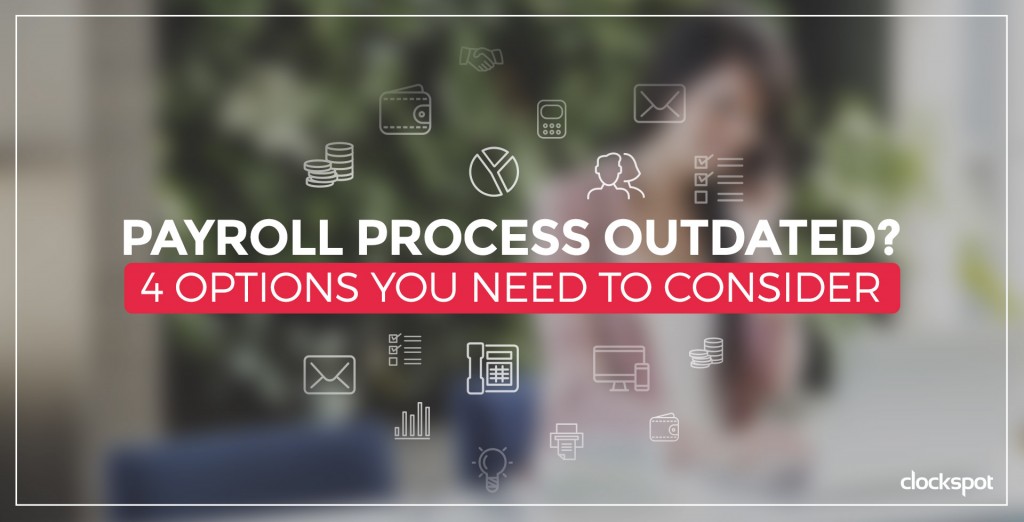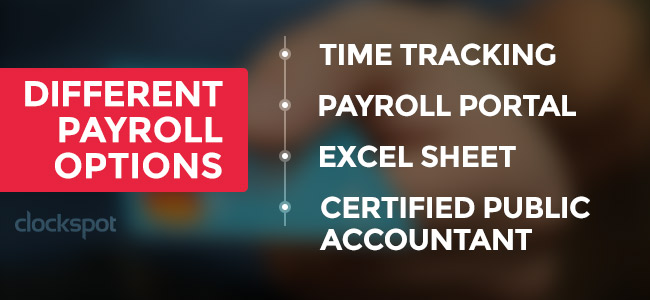
From managing your employees to approving timesheets, plus getting day-to-day tasks done, there’s just so much to worry about.
Your payroll shouldn’t have to be one of them.
Getting a handle on it will save you time and frustration. Unless you have a payroll system that’s running smoothly, you’ll spend way too much time taking care of your company. Make some changes so it’s taking care of you.
WARNING!
An employee is stealing from you.
Download our free ebook to eliminate your risk.
But where do you start? There are multiple payroll options, and each brings with it some advantages and disadvantages.
The key is figuring out what type is best for you and your company.

Things to Consider
Before picking a payroll system, you need to define your own needs.
Consider this:
“Payroll time is not just the time it takes to issue checks and resolve small problems.” (via Source One)
Payroll encompasses other services like benefits, tax reports, vacation approvals, and more. Did you know that 24% of small businesses spend over 120 hours per year dealing with just taxes?
Imagine the time spent including other services. Start by figuring out exactly what you need in a payroll service. Ask yourself:
How Involved Do I Want to Be?
How hands-on do you want to be with your company’s payroll? Do you want a system where you can set it and forget it? Or do you want to be able to input and monitor data on your own?
Most payroll options will fit into one of three categories:
- Completely outsourced. This is where someone else, usually a CPA, bookkeeper or accounting firm, manages your payroll from start to finish. They’ll handle the data entry, calculating the necessary taxes and processing your payroll.
- Partially outsourced. You still handle most tasks, but employ outside tools or services to help. For example, you may choose to do your payroll yourself and have a CPA ensure you’re tax-compliant, or use an outside time tracking tool to keep employees accountable.
- Completely in-house. In this scenario, you handle your payroll yourself. You may purchase software for office or create spreadsheets to assist you.
How Technical Am I?
Running your payroll shouldn’t be difficult or frustrating. And the system you choose should make your job easier, not more difficult.
Determine how much technical help you need when running your payroll. Do you need something that can be accessed from anywhere? Or something that will allow you to run reports and pay employees in mere minutes?
Figure out the level of technical know-how you have, and how much outside help you need.
What’s Our Budget?
Let’s be honest. Cost matters.
Take a close look at your budget and determine just how much you money you can allocate toward payroll management. Besides the initial cost, pay attention to any hidden expenses such as service fees, or any fee schedules based on how many employees or hours you may have.
What Service Options do I Need?
Consider exactly what services you need help with. While you may need help on one aspect of payroll, such as keeping time sheets, you may be perfectly fine with others.
Looking for a payroll option that will fit your specific needs is key to helping your business run smoothly.

Different Payroll Options
Once you've determined exactly what your payroll needs are, start looking at some different options.
Time Tracking
Image: https://pixabay.com/en/clock-time-stopwatch-wrist-watch-95330/
If you simply need a way to keep track of your employees and their hours, then time tracking with secure timesheets is perfect for your business.
By choosing cloud-based timesheets, you can keep track of all your employees using software that’s both reliable and efficient. It can also save you time and money over using a manual time clock or having employees fill out timesheets.
Other benefits of choosing secure time tracking software is:
- It’s easy to use. Time tracking software is usually easy to use, and you can easily add users, employee profiles and more.
- It keeps employees honest. Unlike manual timesheets, hours cannot be fabricated. Every change is tracked, so you can easily see which entries are edited or deleted, plus who made the changes. Even better, IP address monitoring will show you where employees are clocking in from.
- It can be accessed from anywhere. With a cloud-based timesheet, you and your employees can access the system from any device or computer, at any time. Employees can check their hours from any device, and you can review or approve timesheets from anywhere as well.
- It’s secure. All your information is kept secure by top encryption software. You never have to worry about your company information, or your employees’ information being stolen.
- You can easily manage your employees. Timesheets make your job so much easier by giving you easy access to overtime and time off reports, as well as the ability to see who’s working at any given moment.
Payroll Portal
A payroll portal, or employee self-service portal, is a gateway where human resource departments and employees can track time, capture data and create an interactive workplace.
It allows for a “paperless” office, making business processes quicker and easier. Like a time clock option, a payroll portal can be used to track time, but also to process payroll.
Benefits of picking a payroll portal include:
- Get things done faster. Because employees have access to their accounts in the portal, they can easily check their time cards, their status and many other things. Employees can answer most of their own questions without having to call HR. And because employees can log on and manage their own timecards, it streamlines the payroll process, making it much easier (and quicker!) to approve and pay your employees.
- Anytime access. Just like the secure timesheets, you can access a portal 24/7. Want to see who’s working on what? You can do that with a payroll portal. If your employees want to see how many hours they made this week, they can do that too. Even if it’s 11 o’clock on Saturday night.
- Better communication. With most of the internal communication held within the portal or intranet, things just run more smoothly. You no longer have to worry about misplaced messages, and employees don't have to worry whether or not you received their time off request. Everything is kept in one secure location, where everybody has access to the information.
Excel Sheet
If budget is a big concern and if you’re particularly skilled with Microsoft Excel, you can simply use an Excel sheet to track your employees’ time.
Microsoft Office comes with a payroll calculator template that can easily be customized for your business. Follow these steps to get started.
Why would you want to use an Excel sheet? Some benefits of going this route are:
- It’s easy to use. If you’re an Excel expert and already use Microsoft Office in your business, getting started using the payroll template is quick and easy.
- It’s customizable. The payroll template already comes with functions and formulas. Simply enter your employee information such as name, pay rate, tax percentage and deductibles, and the spreadsheet does the rest for you.
- It's easily shareable. With apps like Google Docs and Dropbox, you can easily share your spreadsheet with other managers in your company, and still keep the information protected.
Certified Public Accountant
If you want to completely outsource your payroll, hiring a CPA is a viable option for your business. With years of experience managing finances and payroll, handing your payroll over to a CPA lets you “set it and forget it.”
Other benefits of choosing an accountant are:
- It’s personal. With a dedicated CPA, you get a certain level of personal service. You get that one-on-one contact where you can ask questions and get feedback that you wouldn't get with an online service.
- They handle more than payroll. Besides handling payroll, a CPA might also be able to advise your business in other financial situations.
There are many different options for handling your payroll. But keep in mind that not all payroll options are created equal. Take your personal needs into consideration, look over your budget, and carefully decide which payroll option is right for your business.